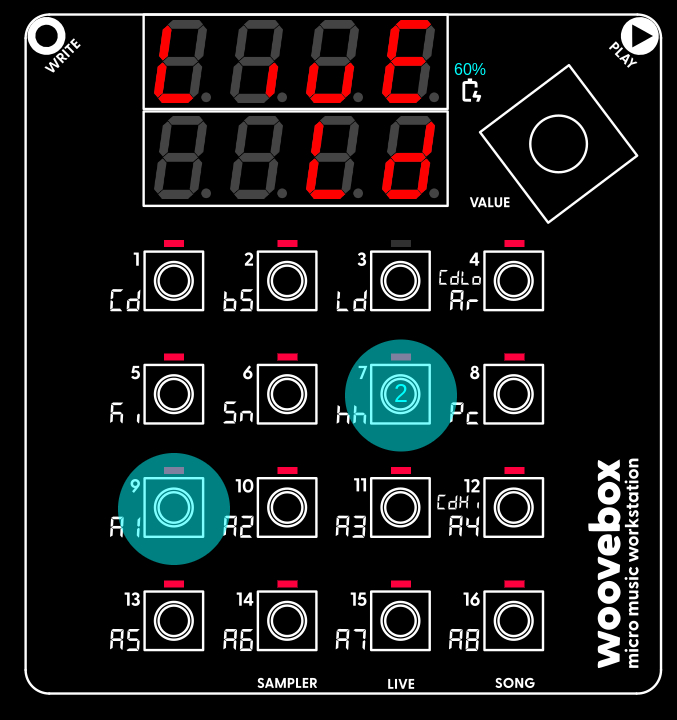- Guides, tutorials and docs
- Learning the Woovebox
- The very basics
- Quick start guide and video
- Tempo and BPM
- Tracks
- Patterns
- Live pattern recording
- Conditional triggering and modification
- Chords
- Arpeggios
- Scales and modes
- Full song writing
- Genres
- Presets
- Sound design
- Paraphonic parts
- Multi-instrument mode
- Risers, fallers, sweeps & ear candy
- Live mode
- Song mode
- Sampler
- Sidechaining, gating, ducking and compression
- Mastering
- Lo-fi & vintage analog and digital emulation
- Randomization
- Hall effect sensor playing
- Advanced techniques
- Undo
- Boot modes
- MIDI, Sync and connecting other gear
- Wireless MIDI over BLE
- Battery and charging
- Hardware quirks and limitations
- Understanding DSP load
- Looking after your Woovebox
- Firmware updates
- Live mode
- Performing with Live mode
Performing with Live mode
Perfoming on your Woovebox in Live mode is straightforward, powerful and rewarding.
At any time, you can play along, create melodies and improvise in real-time by playing key 1-16. The track that will be sounded when you play key 1-16, is indicated on the lower display. To change which track is sounded when you hit a key, hold play until "Slct Trak" ("select track"), then while still holding play, select track 1/Cd-16/A8 to switch to that track. The newly selected track should now be indicated in the lower display.
Before hitting play to start your performance, you may wish to activate a scene to start with (or quickly mute/unmute some tracks by holding write and selecting track 1/Cd-16/A8). Scenes are pre-programmed track configurations that play out over a specified time. For example, you can have one scene that has the kick and hi-hat playing, and another that has the kick, hi-hat and bass playing. Switching between the two scenes builds your track.
To activate the scene you wish to start with, hold play and short-press key 1-16 to choose scene 1-16. The screen will briefly show "Copy Sc." followed by the scene number you selected. You will now notice the tracks have been configured (e.g. muted and unmuted) according to the scene.You can this this during playback as well to jump between scenes and thus track configurations.
A more convenient way to switch between scenes during playback, is to schedule a scene. This makes sure that a scene is triggered when the currently playing scene is elapsed. This can avoid jarring or badly timed transitions (though sometimes jarring might be exactly the sound you are after of course). To schedule a scene transition, hold play and long-press key 1-16 to schedule scene 1-16. The display will indicate "Schd Sc." ("scheduled scene") followed by the scene number you selected. The scene will now only start playing once its starting position is synced up with the playhead. You will see the playhead going in reverse to give you a visual indication of when the new scene will trigger.
Live jamming

Despite its limitations, the Woovebox keyboard can be surprisingly expressive and very much suitable for live playing and improvising complex melodies.
Combined with legato, you can even dynamically create pitch glides; hold 1-16, then quickly play another 1-16 to slide from the first held 1-16 pitch to the second played 1-16 pitch. Note that to use glides, the patch needs to be configured to allow this. You can configure your patch on the 'Pich' (pitch) page; set Live Glide (LLGL) under 3/Ld to 'on'. Then set Legato Speed (LEG.S) under 7/hh to a value other than 0 to control the glide speed.
The way the keyboard translates key presses into note pitches, depends on how the FLW.C (follow chord) parameter on the 'Glob' (global) page is configured for your patch. For example, key presses may be automatically "pulled" toward the root note of the chord that is currently playing, or key presses may be automatically translated to the "legal" notes of the musical scale for your song. Please refer to the documentation to learn more about all the different modes at your disposal.
You may also be interested in...
- Pocketable | Connectable | Playable
- 6. UM.Ln Unmute length (under Patterns)
If 'Mu.Ln' + 'UM.Ln' does not the equal pattern length (Pt.Ln), interesting polymeters can eventuate.
- Build up your song with more elements (under Quick start guide and video)
Now that you have familiarized with programming notes and patterns, you can start building up your track.
- Sidechaining (under Sidechaining, gating, ducking and compression)
A more subtle use of sidechaining, is using to help make specific tracks of your song cut through the mix.
- Restoring patches (under Wooveconnect)
You do not have to be on the patch ("PAch") page for that track.
- Guides, tutorials and docs
- Learning the Woovebox
- The very basics
- Quick start guide and video
- Tempo and BPM
- Tracks
- Patterns
- Live pattern recording
- Conditional triggering and modification
- Chords
- Arpeggios
- Scales and modes
- Full song writing
- Genres
- Presets
- Sound design
- Paraphonic parts
- Multi-instrument mode
- Risers, fallers, sweeps & ear candy
- Live mode
- Song mode
- Sampler
- Sidechaining, gating, ducking and compression
- Mastering
- Lo-fi & vintage analog and digital emulation
- Randomization
- Hall effect sensor playing
- Advanced techniques
- Undo
- Boot modes
- MIDI, Sync and connecting other gear
- Wireless MIDI over BLE
- Battery and charging
- Hardware quirks and limitations
- Understanding DSP load
- Looking after your Woovebox
- Firmware updates